-
Use Cases
-
Resources
-
Pricing
Great Depression Timeline
(1929 - 1939)The Great Depression was a severe worldwide economic depression that lasted from 1929 to 1939.
Stock Market Crash
Black Tuesday
Oct 29, 1929
% complete
Black Tuesday was the stock market crash that occurred on October 29, 1929. It was the most devastating stock market crash in the history of the United States, marking the start of the Great Depression. On that day, the stock market lost billions of dollars in value, leading to widespread panic among investors and a significant decline in consumer spending. The crash had a ripple effect on the economy, causing businesses to fail, unemployment to skyrocket, and banks to close. Black Tuesday is considered a major turning point in American history, significantly impacting the lives of millions of people.
Image source: Wall Street Crash of 1929
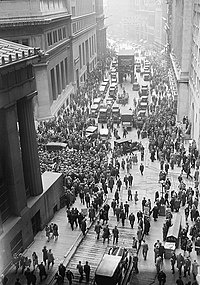
Stock Market Reaches Pre-Crash Levels
Nov 23, 1936
% complete
The stock market reaches the same level as it was before the crash of 1929. This is seen as a sign of recovery and stability in the economy.
Image source: Stock market crash

Social Effects
Dust Bowl Migration
1930 - 1939
% complete
The Dust Bowl Migration, also known as the Great Migration, refers to the movement of approximately 2.5 million people from the Southern Plains to other regions of the United States during the 1930s. This migration was primarily a response to severe drought conditions, coupled with extensive soil erosion and crop failures, which resulted in a devastating agricultural crisis. The migration was triggered by the economic hardships faced by farmers and their families, who were forced to abandon their land and search for work and shelter elsewhere. Many migrants headed westward towards California, hoping to find employment in the agricultural industry. However, the reality often differed from their expectations, as they faced overcrowded camps, harsh living conditions, and fierce competition for jobs. Despite the challenges they encountered, the Dust Bowl migrants played a significant role in shaping the demographic and cultural landscape of the United States. They brought with them their customs, traditions, and music, contributing to the diversity and richness of American society.
Image source: Dust Bowl

Hoovervilles Emerge
1932
% complete
Hoovervilles, named after President Herbert Hoover, were shanty towns that emerged during the Great Depression. They were made up of makeshift shelters constructed by homeless people who had lost their homes due to foreclosure or unemployment. These communities were characterized by their poverty, squalor, and lack of basic amenities like running water and electricity. Hoovervilles became a symbol of the economic hardships faced by many Americans during the 1930s.
Bonus Army March
1932
% complete
The Bonus Army March was a protest by World War I veterans who were demanding the immediate payment of their bonus certificates. The march took place in Washington, D.C., from May 29 to July 28, 1932.
Image source: Bonus Army

International Impact
Hawley-Smoot Tariff Act
Jun 17, 1930
% complete
The Hawley-Smoot Tariff Act was signed into law on June 17, 1930. It raised tariffs on thousands of imported goods and is often credited with exacerbating the global economic downturn of the Great Depression. The act was intended to protect American industries from foreign competition, but resulted in retaliatory tariffs from other countries and a decline in international trade.
Image source: Smoot–Hawley Tariff Act
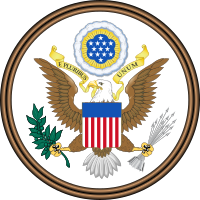
Economic Impact
Bank Failures Begin
Nov 1930
% complete
Bank Failures Begin in November 1930 as a result of the stock market crash and economic downturn. The collapse of major banks leads to a loss of confidence in the banking system and a wave of bank runs and failures across the country. The failure of banks causes widespread panic and further deepens the economic crisis of the Great Depression.
Image source: 2023 United States banking crisis
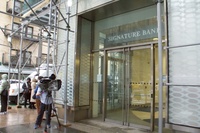
Dust Bowl Begins
1931
% complete
The Dust Bowl was a period of severe dust storms that greatly damaged the ecology and agriculture of the American and Canadian prairies during the 1930s; severe drought and a failure to apply dryland farming methods to prevent wind erosion caused the phenomenon.
Great Depression Ends
Mar 10, 1933
% complete
The Great Depression Ends marks the beginning of the recovery from the economic downturn that had started with the stock market crash of 1929. On March 10, 1933, President Franklin D. Roosevelt declared a national bank holiday, closing all banks to prevent further panic and stabilize the financial system. This was followed by a series of New Deal programs aimed at providing relief, recovery, and reform. These measures helped to stimulate economic growth and restore confidence in the banking system, eventually leading to the end of the Great Depression.
Image source: Great Depression

Recession of 1937-1938
1937
% complete
The Recession of 1937-1938, also known as the Roosevelt Recession, was a severe economic downturn that occurred during the Great Depression. It was characterized by a sudden and sharp decline in industrial production, a decrease in corporate profits, and a rise in unemployment. The recession was triggered by a combination of factors, including a reduction in government spending, a tightening of monetary policy, and a decrease in consumer spending. As a result, the economy went from a period of recovery to a period of contraction. The recession lasted from May 1937 to June 1938, making it one of the shortest but most severe recessions in U.S. history.
Image source: Recession of 1937–1938
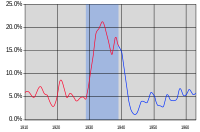
Dust Bowl Ends
1939
% complete
The Dust Bowl Ends refers to the end of a severe drought and dust storms that plagued the Great Plains in the United States during the 1930s. The drought began in 1930 and reached its peak in 1934. However, by 1939, improved weather conditions and government intervention in soil conservation efforts helped bring an end to the Dust Bowl. Rainfall returned to normal levels, and efforts such as planting windbreaks and contour plowing helped prevent soil erosion and restore fertility to the land.
Government Interventions
Franklin D. Roosevelt Elected
Nov 8, 1932
% complete
Franklin D. Roosevelt was elected as the 32nd President of the United States on November 8, 1932. He defeated incumbent President Herbert Hoover in a landslide victory, winning 42 out of the 48 states. Roosevelt's election marked a turning point in American politics as he implemented a series of New Deal programs to address the economic crisis of the Great Depression.
Bank Holiday
Mar 6, 1933
% complete
Bank Holiday was declared on March 6, 1933 by President Franklin D. Roosevelt as a measure to stabilize the banking system during the Great Depression. All banks in the United States were ordered to close for a four-day period to prevent bank runs and to allow the government to assess the financial state and reorganize the banks. This action was part of the New Deal policy to restore public confidence in the banking system.
Emergency Banking Act
Mar 9, 1933
% complete
The Emergency Banking Act was a law passed by the United States Congress in March 1933 in response to the Great Depression. It gave the president the power to regulate banks and reopen those that were deemed solvent. The act helped restore public confidence in the banking system and stabilize the economy.
Civilian Conservation Corps Established
Mar 31, 1933
% complete
The Civilian Conservation Corps (CCC) was established on March 31, 1933, as part of President Franklin D. Roosevelt's New Deal program. Its purpose was to provide employment to unemployed young men during the Great Depression. The CCC focused on natural resource conservation projects, such as reforestation, soil erosion control, and campground construction. Over 2.5 million men participated in the CCC, earning a wage of $30 per month, with $25 sent back to their families. The CCC played a significant role in the conservation and development of national parks, forests, and other public lands.
Image source: Civilian Conservation Corps

Agricultural Adjustment Act
May 12, 1933
% complete
The Agricultural Adjustment Act (AAA) was a United States federal law of the New Deal era designed to boost agricultural prices by reducing surpluses. The AAA granted subsidies to farmers and provided loans to farmers to buy land. The goal of the act was to increase farmers' income and stabilize the agricultural economy. It was enacted on May 12, 1933.
Tennessee Valley Authority Established
May 18, 1933
% complete
The Tennessee Valley Authority (TVA) is created as part of President Franklin D. Roosevelt's New Deal to provide economic development and relief to the Tennessee Valley region. The TVA is tasked with improving navigation, generating electricity, controlling floods, and promoting agricultural development in the area. It is established on May 18, 1933.
Image source: Tennessee Valley Authority

Home Owners' Loan Corporation Established
Jun 13, 1933
% complete
The Home Owners' Loan Corporation (HOLC) was established on June 13, 1933, as part of President Franklin D. Roosevelt's New Deal program. The HOLC was created to help stabilize the housing market and provide relief to homeowners who were struggling to make their mortgage payments. It achieved this by refinancing existing mortgage loans and providing new loans with lower interest rates. The HOLC also implemented a rating system for neighborhoods, known as the Residential Security Maps, which categorized neighborhoods based on their perceived level of risk and creditworthiness. This system had a major impact on the urban landscape by reinforcing discriminatory practices and redlining certain neighborhoods. The HOLC operated until 1951 and is considered one of the most successful New Deal programs.
Image source: Home Owners' Loan Corporation
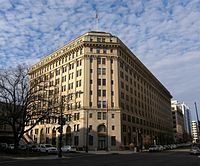
National Industrial Recovery Act
Jun 16, 1933
% complete
The National Industrial Recovery Act (NIRA) was signed into law by President Franklin D. Roosevelt on June 16, 1933. It was a major part of the New Deal program implemented to combat the effects of the Great Depression. The NIRA aimed to stimulate industrial recovery and establish fair labor practices. It created the National Recovery Administration (NRA) to oversee the implementation of codes of fair competition for various industries. These codes set standards for wages, working conditions, and production levels. The NIRA also granted workers the right to organize and bargain collectively through labor unions. While the NIRA was instrumental in stabilizing industrial production and increasing employment, it faced criticism for favoring large corporations and failing to address some of the underlying economic issues causing the Great Depression.
Federal Deposit Insurance Corporation Created
Jun 16, 1933
% complete
The Federal Deposit Insurance Corporation (FDIC) is created to restore public confidence in the banking system after the numerous bank failures during the Great Depression. It provides insurance coverage for bank deposits and helps regulate and supervise banks.
Image source: Federal Deposit Insurance Corporation

Securities and Exchange Commission Created
Jun 6, 1934
% complete
The Securities and Exchange Commission (SEC) is created as part of the New Deal in response to the stock market crash of 1929. It is established to regulate the stock market and protect investors from fraudulent practices. The SEC is given the authority to enforce securities laws, require companies to disclose financial information, and oversee the activities of stock exchanges, brokers, and investment advisors. The commission is composed of five members appointed by the President and confirmed by the Senate. The creation of the SEC marks a significant step towards the regulation and oversight of the financial industry.
Image source: U.S. Securities and Exchange Commission

Works Progress Administration Established
May 6, 1935
% complete
The Works Progress Administration (WPA) is established as part of President Franklin D. Roosevelt's New Deal. The WPA is a federal agency that provides jobs to millions of unemployed Americans during the Great Depression. It focuses on public works projects such as building roads, bridges, schools, and parks. The WPA also supports artists, writers, and musicians by funding projects in the arts.
Image source: Works Progress Administration
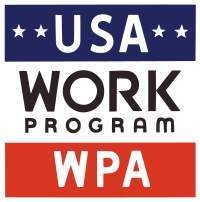
Wagner Act
Jul 5, 1935
% complete
The Wagner Act, also known as the National Labor Relations Act, was passed on July 5, 1935. It was a major labor reform that aimed to protect the rights of workers to organize and bargain collectively. The act established the National Labor Relations Board (NLRB) to enforce these rights and prevent unfair labor practices by employers. The Wagner Act played a significant role in strengthening the labor movement and improving working conditions for millions of Americans during the Great Depression.
Social Security Act Passed
Aug 14, 1935
% complete
The Social Security Act was passed on August 14, 1935, as part of President Franklin D. Roosevelt's New Deal. The act established a social insurance program that provided benefits to retired workers and the unemployed, as well as aid to disabled individuals, dependent children, and the elderly. It was designed to alleviate poverty and promote economic security during the Great Depression.
Fair Labor Standards Act
Jun 25, 1938
% complete
The Fair Labor Standards Act (FLSA) was enacted on June 25, 1938. It is a federal law that establishes minimum wage, overtime pay, recordkeeping, and child labor standards for employees in the private sector and in federal, state, and local governments. The FLSA was created to address the exploitation of workers during the Great Depression and to promote fair labor practices. The Act introduced the federal minimum wage and set the maximum workweek at 44 hours. It also prohibited oppressive child labor and established regulations for overtime pay. The FLSA has been amended several times since its inception, but it remains a vital piece of legislation protecting workers' rights.
Key Facts
- Stock market crash in 1929 triggered the Great Depression.
- Unemployment rate reached 25% in the United States.
- Many banks collapsed and people lost their savings.
- Farming and agricultural communities were hit hard by drought and dust storms.
- The New Deal was implemented by President Franklin D. Roosevelt to help stimulate the economy.
Source
This Great Depression timeline was generated with the help of AI using information found on the internet.
We strive to make these timelines as accurate as possible, but occasionally inaccurates slip in. If you notice anything amiss, let us know at [email protected] and we'll correct it for future visitors.
Create a timeline like this one for free
Preceden lets you create stunning timelines using AI or manually.
Customize your timeline with one of our low-cost paid plans
Export your timeline, add your own events, edit or remove AI-generated events, and much more
Free
$
0
free forever
No credit card required.
Basic
$
10
/month
billed annually
Cancel anytime.
Pro
$
16
/month
billed annually
Cancel anytime.
Common Questions
Can I cancel anytime?
Yes. You can cancel your subscription from your account page at anytime which will ensure you are not charged again. If you cancel you can still access your subscription for the full time period you paid for.
Will you send an annual renewal reminder?
Yes, we will email you a reminder prior to the annual renewal and will also email you a receipt.
Do you offer refunds?
Yes. You can email us within 15 days of any payment and we will issue you a full refund.
What if I have more questions?
Check out our pricing docs or send us an email anytime: [email protected].